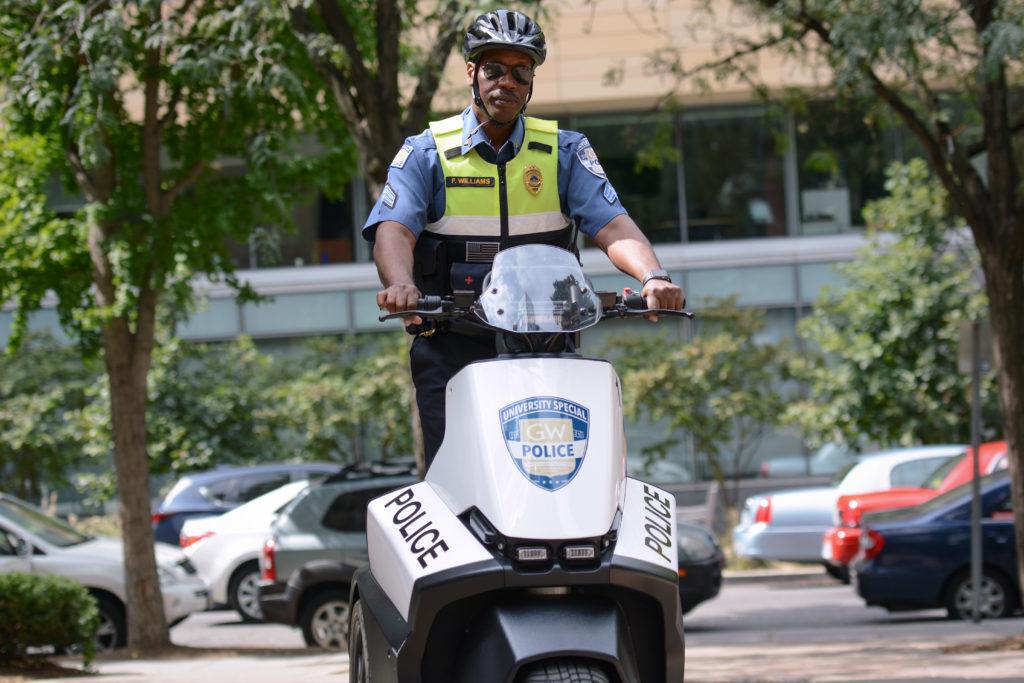To increase interaction with the community, University police have a new tool at their disposal: Segways.
The University Police Department acquired five three-wheeled Segways over the summer, Department Chief RaShall Brackney said. She said the vehicles give officers a strategic advantage when patrolling campus and that students’ curiosity about Segways helps build stronger connections with police.
“It allows our officers to reach out and do community policing without even realizing that it’s exactly what they’re doing,” she said in an interview.
Brackney said the Segways aim to increase visibility, accessibility and reduce barriers between police and the community, because the vehicles encourage officers to be out patrolling the streets, rather than remaining in police cars.
The Segways have been used on patrols and during events on the Foggy Bottom, Mount Vernon and Virginia Science and Technology campuses beginning this academic year. They can travel on roads and through University centers like Kogan Plaza and University Yard, but not on sidewalks unless UPD is responding to an emergency, Brackney said.
The five units together cost about $50,000 and came from Segway, the company, Brackney said.
Brackney said the department chose to buy Segways over new police cars because they were better fit to serve the campus environment at GW and meet the University’s sustainability push. The Segways are battery-powered and do not use fossil fuels, she said.
“We were considering police vehicles, but they didn’t quite meet the needs or expectations and they wouldn’t have necessarily been in alignment for the University’s vision of going green,” she said.
UPD Sgt. Francis Williams said the Segways help create conversations within the community. On one night, 10 different students approached him about the Segways, he said.
“If we were sitting in Kogan Plaza we would be swamped,” he said. “Kids want to come up, they want to find out, it actually makes us feel a little more approachable. They want to have a conversation. They’re very interested about it.”
Williams added that riding a Segway increases his speed and response time to emergency situations, allowing officers to move across campus in two to three minutes.
To use the Segways, Williams and other officers participated in an eight-hour training class and eight hours of practical instruction, where they learned how to maneuver the vehicle through an obstacle course and simulated emergency situations.
About 95 percent of officers are currently trained to use the vehicles, Brackney said.
One UPD officer, who spoke under the condition of anonymity because officers are not allowed to speak with the media, said because Segways can’t be used on sidewalks, it has been difficult to navigate them through rush hour traffic.
“That has become challenging from what I understand. The morning and evening shifts, when there’s a lot of traffic around – having to navigate through H Street and stuff like that where it’s particularly busy,” he said.
Although Segways can bring break down barriers between residents and police, the vehicles can also be difficult to use in certain situations, like in very crowded areas or during severe weather, experts said.
Randy Burba, the university police chief of Chapman University in southern California, said his department has been using Segways for almost 10 years. Burba said the increased height of the vehicles allows officers to monitor crowds more effectively.
“If there are any incidents or something that you would have to respond to, you can kind of get a direct line of sight and get over there because you can see through it,” he said.
Michael Dorn, the executive director of the security consulting firm Safe Havens International, said Segways do help police navigate through large crowds, but they do not help officers pursuing a suspect. UPD’s Segways hit a maximum speed of 15 mph, according to Segway’s website.
“I have always preferred the bicycle because they are more flexible,” he said. “For example, if you are chasing a subject you can take the bicycle with you over an obstacle such as a fence, and continue the chase, whereas with the Segway, you can’t.”
Justine Coleman contributed reporting.





